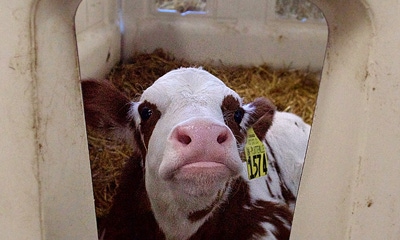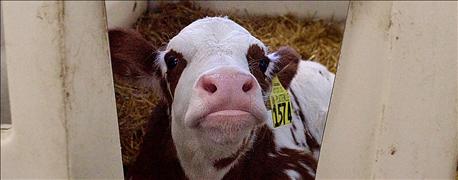October 10, 2016

Too much? Too little? Or just right? When it comes to managing your dairy heifers this winter, you want conditions to be just right. Anything else and you put your heifers at risk for pneumonia and other health issues. You also may be risking another valuable resource: money.
While you may not have control over the weather, you do have control over the environment in which the heifers live. This includes not only their bedding area, but also where they eat, walking surfaces, and any areas they frequently use, both inside and outside.
When cold becomes an issue

CLEAN AND DRY: Providing extra clean and dry bedding during the winter months is a good preventative measure for reducing illness and encouraging high growth rates in your heifers.
For most healthy cattle, the thermal neutral zone (TNZ) is between 32 and 77 degrees F. This refers to the range of environmental temperatures in which the animal does not have to expend energy to maintain its normal body temperature. This zone varies depending on the age of the animal. The TNZ (comfort zone) for newborn calves is between 50 and 78 degrees, while for 1-month-old calves, it's between 32 and 78 degrees. When temperatures are below or above the TNZ — or the critical temperature has been reached — then cattle need to react in order to stabilize their internal temperatures. In the winter they shiver to stay warm, which costs them energy they could be using for growth and immune function.
Extra energy spent in maintenance is wasted energy. For every 1 degree drop below the lower critical temperature, maintenance requirements of the heifer increase 1%. And if increased energy is not provided, heifers have the potential to become sick and even die. You can help heifers with increased energy demands by providing more high-quality feed, calf blankets and cleaner bedding.
Therefore, it’s important to be aware of the outside temperature and manage heifers accordingly. Thermometers inside heifer barns or calf hutches can give you a good idea of what the environmental temperature is in which heifers are living and help you manage heifers accordingly.
Keep heifers dry
Calves and heifers with wet coats or in wet living conditions during the winter have a lower critical temperature than heifers that are dry and clean. Keeping these animals healthy also means more management. Therefore, it’s vital to keep heifers as clean, dry and free from moist environments as possible.
Very cold weather can cause frost or condensation to build in heifers’ living environment. Also, heifers produce water vapor through breathing, raising the relative humidity in the environment, which can condense on and around the animal. It’s important to minimize this as much as possible, as excess moisture buildup causes bacterial growth or dampness on the animal’s coat.
Focus on where the heifers rest. Ensure that it is clean and dry with plenty of bedding. Based on University of Wisconsin-Madison research, calves tend to lie down nearly 50% of the time during the day and 100% of the time at night. Bedding is important to heifer health and management in the winter. Wet bedding causes the hair coat to clump and lose insulation value. Ideal bedding provides a good base to soak up liquid, provide a buffer from the cold ground, provide insulation and allow the calf to nestle.
Dairy Calf and Heifer Association Gold Standards recommend 6 to 12 inches or 20 to 25 pounds of bedding per calf to provide a good base. To maintain the base, 2 to 3 pounds of bedding per day should be added to the pen or hutch. The amount of bedding used is more important than the specific material used.
Extra clean and dry bedding provided during the winter months is a good preventative measure for reducing illness and keeping high growth rates in your heifers.
Say 'no' to drafts
Proper ventilation is key for heifer health and management during the winter. Both stagnant air and drafts must be avoided to protect heifers from being chilled or forced to breathe in stale air.
Even in winter, heifers need plenty of fresh air with minimal drafts. Circulating fresh air around heifers helps remove bacteria from the air, keep dust levels down, eliminate noxious odors and remove excess moisture.
University of Wisconsin School of Veterinary Medicine research shows that as temperatures fall, pneumonia incidences rise. Pneumonia can be attributed to cold stress and calves not meeting their energy needs to support their immune systems. Pneumonia also can be attributed to poor air quality as barns are closed up during the winter. Closing heifers off from fresh air reduces drafts, but it also causes damage by recirculating air contaminated by bacteria and other harmful compounds.
DCHA Gold Standards II indicates indoor ventilation should be 50 cubic feet per minute during mild weather and 15 CFM during cold weather to provide good air quality while minimizing cold air drafts.
Fresh air and sunlight, even in winter, help reduce illness in heifers. Orientate calf hutches and other shelters to maximize sunlight penetration and protect calves from prevailing winds and drafts in winter.
Depending on the housing system you use for calves and heifers, using fans to circulate fresh air without causing drafts can be an easy tool for proper ventilation.
For more information on winter management and housing systems for calves and heifers, visit the UW Extension Dairy Team Dairy Calf and Heifer Management web page, or contact your local Extension office.
Blazek is the Dane County Extension dairy and livestock agent.
You May Also Like




